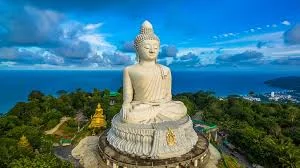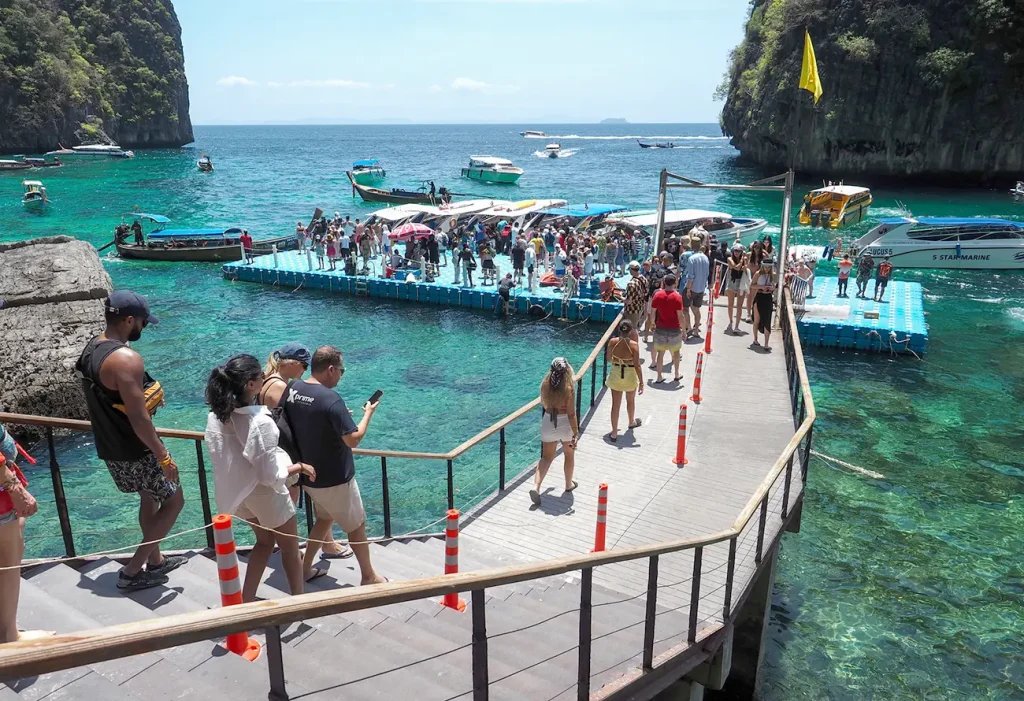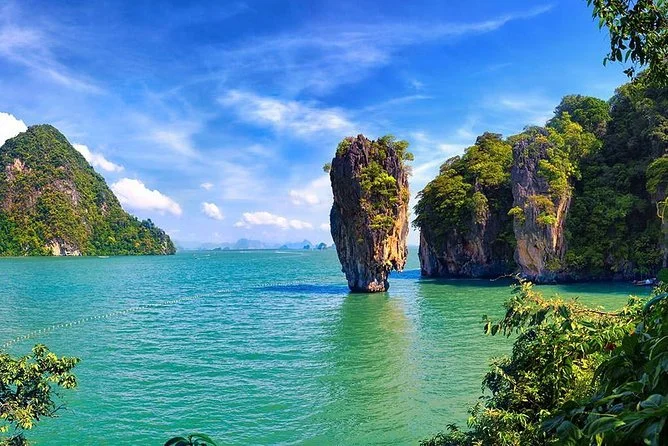Thailand Tour Packages
Thailand Honeymoon Tour Packages
Thailand Paradise Tour Package
Bangkok Phuket Krabi Tour Packages
Thailand Best Seller Tour Package
Discover the Magic of Phuket in July: What to Expect
let’s discuss what you can expect from visiting Phuket in July, and how you will be able to enjoy your trip and discover some hidden gems on the island! The largest island in Thailand, Phuket, is known for its stunning beaches, fun nightlife, and rich culture. So when July rolls around, it means the onset of the rainy season, meaning that the beaches are less crowded, the plants are super green, and there are lots of local festivals to enjoy. Some might have concerns about traveling at that time of year, but those who travel during these times often find it produces special experiences that will save them money. While many people see this beautiful island as a destination for summer holidays, visiting this place in July can reveal the other, perhaps more unique aspect that few may get to enjoy.
Book here our Thailand tour packages.
Pros and Cons of Visiting Phuket in July
Pros:
1. Lower Prices: July falls in the off-peak monsoon season, so you’ll find more affordable accommodation, tours, and activities. Hotels and resorts often offer discounts, making it an ideal time for budget-conscious travelers.
2. Fewer Tourists: With fewer visitors around, you can enjoy popular attractions, beaches, and restaurants without the usual crowds. It’s a great time to experience a more peaceful and authentic side of Phuket.
3. Lush Landscapes: The rains during July enhance the island’s natural beauty, bringing lush greenery to the beaches and forests. The waterfalls are at their most spectacular, offering stunning photo opportunities.
4. Quieter Beaches: Phuket’s beaches are much quieter in July, allowing you to relax in a more serene environment. You can enjoy the sand and sea without fighting for space, and the calm atmosphere makes it perfect for unwinding.
Cons:
1. Unpredictable Weather: July is part of the monsoon season, so you’ll experience frequent rain showers and storms. The weather can be unpredictable, making outdoor activities a bit challenging at times, especially during heavy rain.
2. Rough Sea Conditions: The sea is often rough in July, which can impact water-based activities like snorkeling, diving, and boat tours. Some tours may be canceled due to safety concerns, and sea conditions can make some islands harder to reach.
3. Humidity: High humidity levels can make the weather feel hotter and more uncomfortable, especially during the day when it’s wet and sticky. It’s important to stay hydrated and wear light, breathable clothing.
4. Limited Water Sports: Due to rough seas and high rainfall, certain water sports such as jet skiing, parasailing, and kayaking may be less enjoyable or unavailable in July. It’s advisable to check conditions in advance before booking such activities.
Weather Conditions of Phuket in July
July in Phuket tends to be during the height of the monsoon season, and therefore expect it to be relatively wetter with higher humidity levels. While the temperature tends to remain at a warm 30°C (86°F), one can still anticipate heavy afternoon and evening showers, which sometimes become heavy rain lasting several hours. Nevertheless, such storms usually clear rapidly, so that the day can also contain some sunshine. The sea conditions might also be a bit rough during July, hence water activities will not be that predictable. Nonetheless, the number of tourists in this month is relatively few; hence it would be peaceful, authentic, and less expensive regarding accommodation.
Top Places to Visit in Phuket in July
1. Big Buddha

The Big Buddha, one of Phuket’s most iconic landmarks, stands 45 meters tall and offers panoramic views of the island. Even with occasional rain, the location remains peaceful and provides great opportunities for photography. The lush surroundings and serene atmosphere make it a perfect spot for quiet reflection. The misty, cloudy skies during the monsoon season add a unique element to the experience.
2. Phi Phi Islands

Although July brings rougher seas, if the weather allows, a boat trip to the Phi Phi Islands can still be a breathtaking experience. The islands offer stunning landscapes, crystal-clear waters, and opportunities for snorkeling or relaxing on the beach. The islands are much less crowded during the monsoon season, allowing for a more tranquil experience.
3. Phang Nga Bay

Phang Nga Bay is known for its dramatic limestone karsts and emerald-green waters. The bay is famous for the iconic James Bond Island, and exploring it by kayak or boat is a must-do. July’s rainy season makes the bay more lush and photogenic, and with fewer tourists around, you can enjoy a more intimate experience.
4. Old Phuket Town

Old Phuket Town is a great place to explore on rainy days, as the colorful colonial-style buildings provide a charming and cultural backdrop. Walk along the streets filled with street art, local shops, and cafes. In July, you can avoid the crowds and truly immerse yourself in the area’s history and architecture, while enjoying the cozy atmosphere of local eateries.
5. Kata Beach

Kata Beach offers a quieter alternative to the more popular Patong Beach, and in July, it’s peaceful with fewer tourists around. While the weather can be rainy, the beach still has opportunities for enjoying the sea when the weather clears. It’s ideal for swimming and relaxing, with a great selection of beachfront restaurants to enjoy on overcast days.
What should you pack for the July trip to Phuket?
1. Lightweight Clothing: Pack breathable, lightweight clothing that can keep you cool in the humidity. Fabrics like cotton and linen are great choices.
2. Rain Gear: A waterproof jacket or poncho is essential for unexpected downpours. An umbrella can also be handy.
3. Swimwear: Don’t forget your swimsuits! Even with the rain, there will be opportunities to swim or relax at the beach when the weather permits.
4. Waterproof Footwear: Bring flip-flops or waterproof sandals for the beach, and consider lightweight, waterproof shoes for exploring.
5. Quick-Dry Towel: A compact towel that dries quickly is useful after swims or sudden rain showers.
6. Sun Protection: Sunscreen with high SPF, sunglasses, and a wide-brimmed hat are important to protect yourself from the sun when it’s out.
7. Insect Repellent: Due to the lush greenery and the humidity, mosquitoes can be prevalent. A good insect repellent is a must.
8. Snorkeling Gear (Optional): If you plan to go snorkeling, consider bringing your gear, though rentals are often available.
Tips for Travelling to Phuket in July
1. Pack for the Rainy Season: July is the monsoon season, so pack lightweight, breathable clothing and a waterproof jacket. Be prepared for sudden downpours, and make sure to bring waterproof shoes or sandals to stay dry.
2. Stay Flexible with Your Plans: The weather can be unpredictable in July, so keep your plans flexible. Have backup indoor activities in mind in case outdoor excursions are disrupted by rain or rough seas.
3. Check Weather Forecasts Regularly: Keep an eye on the weather forecast before heading out for the day. Many tours adjust schedules based on weather, and some may cancel boat trips or other outdoor activities.
4. Visit Indoor Attractions on Rainy Days: If rain hits, take advantage of indoor activities such as museums, shopping malls, or cultural shows. You can also enjoy a relaxing spa day or take a cooking class to stay entertained.
5. Be Mindful of the Humidity: Even with rain, the humidity can be high, so stay hydrated and wear sunscreen when the sun comes out. Loose-fitting clothes will help you stay comfortable, and air-conditioned spaces offer relief from the heat.
6. Take Advantage of Lower Prices: Since July is an off-peak month, you can find great deals on hotels and tours. Take advantage of lower prices on services like massages, boat trips, and accommodations during this quieter time.
7. Avoid the Rough Seas for Water Activities: The sea can be rough in July, which might affect boat tours, diving, or snorkeling. Always check conditions with your tour operator and prioritize safety before booking water-based activities.
8. Rent a Scooter for Easy Travel: Renting a scooter is a convenient way to explore Phuket at your own pace. Be cautious of slippery roads during rainstorms, and always wear a helmet for added safety.
Conclusion
In conclusion, visiting Phuket in July offers a unique and peaceful experience with fewer tourists, lower prices, and the lush beauty of the monsoon season. While the rainy weather and rough seas can pose some challenges, the off-peak atmosphere allows for a more relaxed exploration of the island’s beaches, cultural sites, and natural wonders. With flexibility, proper preparation, and a positive attitude toward the rain, you can still enjoy a memorable and rewarding vacation. Phuket in July may be quieter, but it provides an opportunity to experience the island in a way that’s less commercialized and more serene.
Book here our Thailand tour packages.
People also ask about Phuket in July
1. Is it a good idea to visit Phuket in July?
Yes, if you don’t mind the rainy season, July offers a quieter and more affordable experience. The island is less crowded, and you can enjoy the lush green landscapes, peaceful beaches, and lower prices.
2. What is the weather like in Phuket in July?
The weather in July is typically rainy, with heavy showers and high humidity. While you may experience some sunshine, frequent rainstorms and rough seas are common, so be prepared for wet conditions.
3. Will I be able to enjoy the beaches in July despite the rain?
Yes, although rain is frequent, it usually comes in short bursts. Many beaches like Kata and Karon will be less crowded, and you can still enjoy the sand and sea during breaks in the weather.
4. Can I still do water activities like snorkeling or diving in July?
Water activities may be limited due to rough seas and strong currents. Always check the weather conditions and tour availability beforehand, as some tours may be canceled or rescheduled for safety reasons.
5. How should I prepare for the humidity in Phuket during July?
To stay comfortable, wear lightweight, breathable clothing and drink plenty of water. Carry sunscreen and stay indoors or in shaded areas when the sun is strong to avoid heat exhaustion.
6. Are there any special events or festivals in Phuket in July?
Phuket in July doesn’t host large festivals, but there are smaller cultural events and local celebrations. You may experience local Buddhist ceremonies or unique regional events that reflect the island’s traditions.
